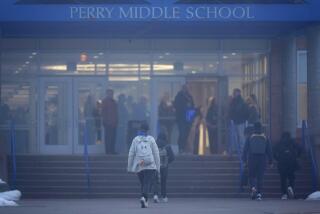Salvaging hope at Iowa mosque
- Share via
CEDAR RAPIDS, IOWA — The tiny white mosque in a working-class neighborhood on this city’s west side is a muddy shell with a sewage-stained stack of Korans and prayer beads piled nearly 5 feet high out back.
For more than seven decades, Muslim immigrants searching for solace and strength have gathered at the Mother Mosque of America, the oldest surviving mosque in North America.
Now, the memories have been washed away. Picking through the debris, the faithful struggle to find something they can salvage -- even if it’s only a little hope.
“We have lost our homes, our businesses and our places of worship,” said the mosque’s leader, Imam Taha Tawil. “We have a lot to rebuild, but we can do it.”
Nearly three weeks after the surging Cedar River crested well above historic levels and swamped 1,300 city blocks, the worship center and the 50 families it serves are among the tens of thousands of flood victims here in the state’s second-largest city.
They are far from alone in the struggle to rebuild their lives. Hundreds of communities in six states face vexing questions and mounting fears after the widespread flooding.
In Iowa alone, the floods affected 350 of the state’s 949 towns, damaged 45,000 square miles of land and displaced 40,000 people, said Gov. Chet Culver.
Cedar Rapids has some of the most daunting hurdles to overcome. More than 5,300 homes and 1,100 commercial and industrial business structures were damaged. So were 486 government buildings, schools and other nonprofit entities.
That includes 31 places of worship. Warped pews, stained crucifixes and muck-covered prayer stands littered the parking lots of two Methodist parishes and a Catholic church -- all within a mile of Mother Mosque.
The floods created a mountain of soggy debris that will top 300,000 tons, more than a normal year’s worth of garbage disposal.
That pile will probably grow: City Manager Jim Prosser and several City Council members have indicated that as many as 1,000 homes may be torn down -- essentially eradicating all structures within the city’s 100-year-flood plain.
Still uncertain are the fate of 1,900 homes in the city’s 500-year-flood plain, as well as the neighborhood where the mosque was built in 1934 as a spiritual home for Muslims.
The mosque, a small white structure on a street of blue-collar families and aging maple trees, was first built for use by a few dozen Muslim families who had been drawn to the area in the late 1800s by the rich farmland surrounding Cedar Rapids.
By the early 1970s, the community had grown large enough that the mosque’s tiny prayer room and basement kitchen -- used every Sunday for potluck dinners -- was too small to handle a booming population from more than 15 countries, including Lebanon, Jordan and Egypt.
A new, larger mosque was built across town, and Mother Mosque was sold. After its new owners abandoned the building in the 1980s, the Islamic Council of Iowa repurchased it in 1990. A renovated Mother Mosque began offering services again in 1993.
“It became the place where we could preserve the heritage and traditions of the Islamic community, here in Iowa and America,” Tawil said. “It’s why this flood is so hard. We’ve lost a century’s worth of art and oral history and work.”
Handwritten journals are gone. Photographs from the late 1800s are so damaged they’ve been tossed into a Dumpster. Religious books black with mold are waiting to be buried or burned according to tradition, Tawil said.
The shed in the backyard is also destroyed, along with the writings and recordings of T.B. Irving, who lived in Cedar Rapids and penned an early English translation of the Koran.
For days, members of the mosque -- as well as volunteers from churches and synagogues -- have spent long days searching for something to save.
As one group of young men slogged through the muck, and another drew up lists of construction supplies needed to rebuild the mosque’s basement library, neighbor Phil Malone leaned wearily over a wooden picket fence to commiserate with Tawil.
“What’s the point in trying to come back?” asked Malone, 73, a retired repairman for an electronics firm.
Tugging off his soiled rubber gloves, Malone pointed across the street. That house was set to be demolished next week. Down the block, he said, two others would be gone by summer’s end.
Malone and his wife, Mona, aren’t sure what their own future holds. They feel paralyzed by uncertainty. Why try to rebuild if the neighborhood is essentially deserted?
The flood sent waist-high water crashing through the couple’s living room and bedroom. The kitchen cabinets were bowed and contorted; the wooden deck outside was upended.
The Malones, for now, are homeless and bunking at different relatives’ homes.
“Do we roll the dice?” Phil asked. “I don’t know if we should rebuild, or not even bother. I don’t know what to do. We’re all feeling lost.”
Tawil gave his neighbor a sympathetic look and nodded. He’s heard the same from friends, relatives, members of the mosque. None of it dampens his determination.
“We can’t give up,” Tawil said. “We will rebuild. So can you.”
More to Read
Sign up for Essential California
The most important California stories and recommendations in your inbox every morning.
You may occasionally receive promotional content from the Los Angeles Times.













